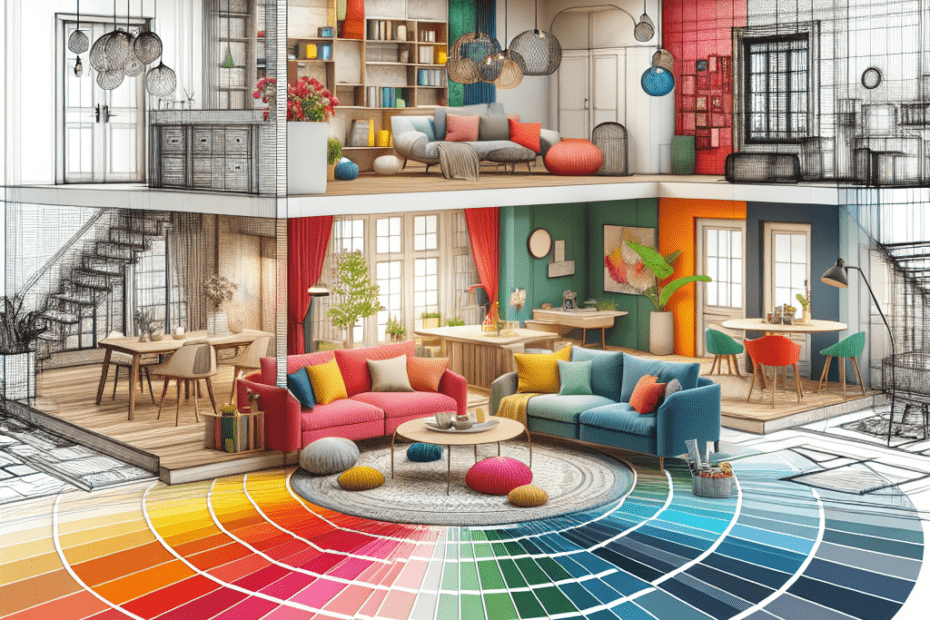Creating Visual Flow with Color in Open-Plan Homes
Open-plan homes have become increasingly popular for their spacious, airy feel and the flexibility they provide. However, this design choice comes with the challenge of creating a cohesive visual flow. By using color strategically, homeowners can ensure their open-plan spaces feel connected and harmonious. This article will explore how color flow in open homes can transform your living area into a seamless and aesthetically pleasing environment.
Understanding Color Flow in Open Homes
Color flow in open homes refers to the strategic use of colors to create a seamless connection between different areas. Open-plan designs often include spaces like the kitchen, dining area, and living room in a single large area without any walls separating them. Without a strong visual cue, these large spaces can feel disjointed. Colors can act as a visual pathway that guides the eyes from one zone to another.
The Importance of Color Choice
According to a study by Design Insights Magazine, 73% of interior designers agree that color choice is essential in making open-plan spaces appear cohesive.1 The colors chosen should complement each other and maintain a balance between unity and variety.
| Design Aspect | Percentage of Importance |
|---|---|
| Color Choice | 73% |
| Furniture Layout | 57% |
| Lighting | 27% |
Using a Base Color
The first step in achieving color flow is selecting a base color that will dominate the space. This color should be used on large surfaces like walls. Neutrals are often a favorite choice since they are versatile and blend easily with other shades. The base color helps to establish a sense of continuity across different areas.
Incorporating Accent Colors
Accent colors can add depth and dimension to open-plan spaces. They should be used in moderation on smaller elements such as throw pillows, rugs, or artwork. To maintain a cohesive look and add energy to the space, choose about two or three accent colors that complement the base color.
Complementary Color Schemes
Using a complementary color scheme involves selecting colors opposite each other on the color wheel. This approach can enhance the color flow by adding contrast and interest. For instance, if your base color is a soft blue, you can incorporate hints of orange as an accent color for balance.
Layering with Textures
Combining different textures with your chosen colors can also amplify the color flow. Textural variations like wood grains, fabrics, and metal finishes can reflect and absorb light differently, thereby enhancing the visual interest without disrupting the harmony of the color flow.
Adapting to Natural Light
Natural light can greatly affect how colors are perceived in open-plan homes. South-facing rooms tend to have warm sunlight, which complements cooler shades, while north-facing rooms benefit from warmer colors to compensate for the lack of direct sunlight. Understanding the natural light dynamics in your open space is crucial for maintaining color flow.
Case Study: A Seamless Color Experience
Consider the example of a family choosing to renovate their open-plan kitchen and living area. They decided on a warm beige as the base color to unify the space. By using olive green and terracotta accents on cushions and curtains, they achieved a natural aesthetic. Additionally, they incorporated wooden furniture and metallic lighting fixtures to add depth through texture. The result was a harmonious, well-flowing open-plan area that felt both inviting and diverse.
Key Takeaways
- Color flow in open homes is crucial to creating visually connected living spaces.
- Select a base color for continuity and complementary hues for accents.
- Consider natural light dynamics when choosing your color palette.
- Textures can enhance the perception of color and add depth.
FAQs
-
What is color flow in open-plan homes?
Color flow refers to the use of color to create a visually cohesive and connected environment in open-plan spaces.
-
Why is a base color important?
The base color is applied to large areas, helping to unify various parts of a space and create a continuous flow.
-
How do accent colors enhance an open-plan design?
Accent colors add depth and interest. They provide contrast and complement the base color to make the space visually engaging.
-
What role do textures play in color flow?
Textures add another layer of visual interest without disrupting the color harmony. They help in reflecting light in diverse ways.
-
What should you consider about natural light?
Natural light can change how colors look. It’s essential to adapt your color choices based on the light a room receives throughout the day.
1 Source: Design Insights Magazine, 2022 Survey on Interior Design Trends
